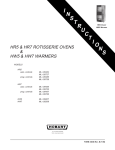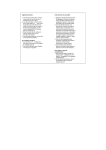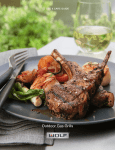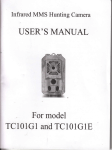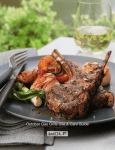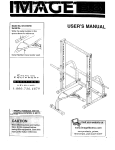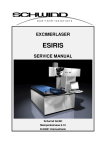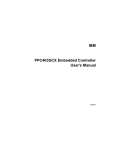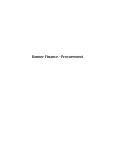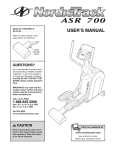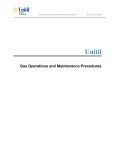Download Outdoor Grill (OG) Series
Transcript
Technical Service Manual Outdoor Grill (OG) Series © WOLF APPLIANCE, INC. 2009 ALL RIGHTS RESERVED JOB AID #814144 Revision A - July, 2009 Outdoor Grill (OG) Series General Information SECTION 1 GENERAL INFORMATION 1-1 #814144 - Revision A - July, 2009 General Information Outdoor Grill (OG) Series INTRODUCTION This Technical Service Manual has been compiled with information provided by Twin Eagles, Inc. This manual provides the most recent technical service information for the Outdoor Grill (OG) Series and its associated sales accessories. The information in this manual will enable the service technician to troubleshoot and diagnose malfunctions, perform necessary repairs and return an OG Series product to proper operational condition. The Service Technician should read the complete instructions contained in this Technical Service and Parts Manual before initiating any repairs on an OG Series product. IMPORTANT SAFETY INFORMATION TECHNICAL ASSISTANCE Below are Product Safety Labels used in this manual. The "Signal Words" used are WARNING or CAUTION. If you should have any questions regarding the appliance and/or this manual, please contact: When reviewing this manual, please note these different Product Safety Labels placed at the beginning of certain sections of this manual. You must follow the instructions given in the boxes of the Product Safety Labels in order to avoid personal injury and/or product damage. Wolf Appliance, Inc. ATTN: Service Department P.O. Box 44988 Madison, WI 53744 - 4988 Customer Assistance Phone #: (800) 332 - 9513 Facsimile #: (608) 441 - 5887 The sample Product Safety Labels below illustrate the precautions that should be taken when the signal word is observed. Technical Assistance (For Technicians in Customer’s Homes Only) Phone #: (800) 919 - 8324 INDICATES THAT HAZARDOUS OR UNSAFE PRACTICES COULD RESULT IN SEVERE PERSONAL INJURY OR DEATH! Warranty Claims Phone #: (800) 332 - 9513 Facsimile #: (608) 441 - 5886 Service Department e-mail Address: [email protected] Indicates that hazardous or unsafe practices could result in minor personal injury, and/or product damage, and/or property damage! Office Hours: 7:00 AM to 6:00 PM Central Time Monday through Friday In addition, please pay attention to the signal word “NOTE”, which highlights information that is especially important for the topic being covered. This manual is designed to be used by Authorized Service Personnel only. Wolf Appliance, Inc. assumes no responsibility for any repairs made on Wolf appliance units by anyone other than Authorized Service Technicians. The information and images contained in this manual are the copyright property of Wolf appliance, Inc. Neither this manual nor any information or images contained herein may be copied or used in whole or in part without the express written consent of Wolf Appliance, Inc.©, all rights reserved. #814144 - Revision A - July, 2009 1-2 Outdoor Grill (OG) Series General Information TABLE OF CONTENTS Page # Page # Section 1 - General Information ..................................... 1-1 Introduction......................................................................... 1-2 Important Safety Information.............................................. 1-2 Technical Assistance.......................................................... 1-2 Table of Contents............................................................... 1-3 Warranty Information......................................................... 1-4 Model/Serial/Rating Plate Tags ......................................... 1-5 Model Number Key............................................................. 1-5 OG Models and Descriptions............................................. 1-6 OG Feature..................................................................... 1-7 OG Cart Models and Descriptions..................................... 1-8 OG Cart Feature............................................................. 1-9 Section 3 -Theory of Operation ...................................... 3-1 Operation Information ....................................................... 3-2 Types of Fuel Gases ..................................................... 3-2 Heating Value of Gas .................................................... 3-2 Specific Gravity of Gas .................................................. 3-2 Principals of Gas Combustion ....................................... 3-3 Types of Burners .............................................................. 3-4 Blue Flame Burners ...................................................... 3-4 Infrared Burners ............................................................ 3-4 Simple Theory of Operation .............................................. 3-5 Section 2 - Installation Information ............................... General Installation Information ....................................... Regulations .................................................................... Important Instructions to the Owner ............................. Locating the Grill .............................................................. Portable Applications ..................................................... OG and Cart Overall Dimensions .................................. Built-in Applications ....................................................... Minimum Clearances ............................................... Insulating Liner ......................................................... OG Built-in Installation Dimensions .............................. Electrical Requirements ................................................... Install the Transformer .................................................. Cart Application ......................................................... Built-in Application ..................................................... Rotisserie Motor ............................................................ Gas Safety Requirements ................................................ Gas Supply Requirements ............................................... Natural Gas Installations .................................................. Natural Gas Safety Requirements ................................ Natural Gas Connection ................................................ LP Gas Installations ......................................................... LP Gas Safety Requirements ........................................ LP Gas Installations (Portable LP Connection) ............. LP Gas Connection ....................................................... Gas Leak Testing ............................................................. Gas Leak Testing Procedure ........................................ Outdoor Grill Assembly ..................................................... Installing Briquette Trays .............................................. Installing Grill to Cart .................................................... Section 4 - Component Access and Removal .............. 4-1 Component Access and Removal Table of Contents ....... 4-2 Warnings and Cautions .................................................... 4-2 2-1 2-2 2-2 2-2 2-2 2-2 2-3 2-4 2-4 2-4 2-5 2-6 2-6 2-6 2-6 2-6 2-6 2-6 2-7 2-7 2-7 2-7 2-8 2-8 2-8 2-9 2-9 2-9 2-9 2-9 Section 5 - Troubleshooting Guide ............................... How to Use the Troubleshooting Guide ........................... Troubleshooting Guide Table of Contents ........................ Troubleshooting Guide ...................................................... 5-1 5-2 5-2 5-3 Section 6 - Technical Data.............................................. 6-1 Technical Data Table ........................................................ 6-2 Section 7 - Wiring Diagrams .......................................... 7-1 OG Connection Diagram / Ladder Diagram ..................... 7-1 1-3 #814144 - Revision A - July, 2009 General Information Outdoor Grill (OG) Series WARRANTY INFORMATION This page contains a copy of the One (1) Year Outdoor Warranty supplied with every Wolf OG Series unit. On the following page is the serial number information, which is needed for warranty purposes. Wolf Appliance Outdoor Products Limited Warranty RESIDENTIAL USE ONLY FULL ONE (1) YEAR WARRANTY* For one year from the date of original installation, the Wolf Appliance product warranty covers all parts and labor to repair or replace any part of the product that proves to be defective in materials or workmanship. All service provided by Wolf Appliance under the above warranty must be performed by a Wolf authorized service center, unless otherwise specified by Wolf Appliance. Service will be provided in the home during normal business hours. LIMITED LIFETIME WARRANTY For the life of the product, Wolf Appliance will repair or replace any outdoor gas grill body or hood that rusts through due to defective material or workmanship. Labor to remove and replace defective parts is not covered. Wolf Appliance recommends that a Wolf authorized service center is used to perform such service. TERMS APPLICABLE TO EACH WARRANTY The warranty applies only to products installed for normal residential use. The warranty applies only to products installed in any one of the fifty states of the United States, the District of Columbia or the ten provinces of Canada. This warranty does not cover any parts or labor to correct any defect caused by negligence, accident or improper use, maintenance, installation, service or repair. THE REMEDIES DESCRIBED ABOVE FOR EACH WARRANTY ARE THE ONLY ONES THAT WOLF APPLIANCE, INC. WILL PROVIDE, EITHER UNDER THIS WARRANTY OR UNDER ANY WARRANTY ARISING BY OPERATION OF LAW. WOLF APPLIANCE, INC. WILL NOT BE RESPONSIBLE FOR ANY CONSEQUENTIAL OR INCIDENTAL DAMAGES ARISING FROM THE BREACH OF THIS WARRANTY OR ANY OTHER WARRANTY, WHETHER EXPRESSED, IMPLIED OR STATUTORY. Some states do not allow the exclusion or limitation of incidental or consequential damages, so the above limitation or exclusion may not apply to all customers. This warranty gives customers specific legal rights and they may also have other legal rights that vary from state to state. To receive parts and/or service and the name of the Wolf authorized service center, contact Wolf Appliance, Inc., P.O. Box 44848, Madison, WI 53744; check the contact & support section of our website, wolfappliance.com or call 800-332-9513. * Stainless steel body, hood, doors, panels, handles, product frames and stainless interior surfaces are covered by a limited 60-day parts and labor warranty for cosmetic defects. #814144 - Revision A - July, 2009 1-4 General Information Outdoor Grill (OG) Series OG MODEL/SERIAL TAG AND RATING PLATE/SERIAL TAG A model/serial tag is attached to the bottom flange of the grill’s front panel. This tag contains only the model number, manufacturer number and serial number (See Figures 1-1 & 1-3). The rating plate/serial tag is located behind the front panel, above the drip tray. It contains gas and electrical rating information as well as the model number, manufacturer number and serial number (See Figures 1-2 & 1-3). MODEL: OG36-LP Mfg. 0910 11360000 SN: Figure 1-1. Model / Serial Tag Layout C Fitchburg, WI USA US 3025103 MODEL: OG36-LP GRILL BURNER 25,000 41 DSM ROTIS, 36” 14,000 50 DSM SEAR BURNER 24,000 44 DSM MANIFOLD PRESSURE: 10” W.C. (LP GAS), 89,000 BTU/hr ELECTRICAL RATINGS: 120VAC, 1.1A, 50/60Hz Mfg. 0910 MINIMUM CLEARANCE FROM SIDES AND BACK OF UNIT TO ADJACENT COMBUSTIBLE CONSTRUCTION: 12 INCHES DO NOT LOCATE THIS APPLIANCE UNDER OVER- HEAD UNPROTECTED COMBUSTIBLE SURFACES. FOR USE WITH A GAS APPLIANCE REGULATOR. THE REGULATOR SUPPLIED MUST BE USED WITH THIS APPLIANCE. FOR OUTDOOR USE ONLY. IF STORING LP MODELS INDOORS, DETACH AND LEAVE LP CYLINDER OUTDOORS. WHEN NOT IN USE, THE GAS SUPPLY MUST BE TURNED OFF AT THE LP-GAS SUPPLY CYLINDER. CAUTION: THE CONNECTION TO AN EXTENSION CORD SHOULD BE KEPT DRY AND OFF THE GROUND. 11360000 SN: CONFORMES WITH ANSI STD Z21.58-2007 CERTIFIED TO CGA STD 1.6-2007 Location of Tags Figure 1-2. Rating Plate / Serial Tag Layout Figure 1-3. Tag Location MODEL NUMBER KEY The diagram below explains the model number code of the Outdoor Grill line of products. OG36-LP Model Line and Domestic/International Identifier: OG = Domestic Outdoor Grill Model Nominal Width: 13” 30”, 36”, 42” Fuel Type: -LP = Liquid Propane Gas (BLANK) = Natural Gas Outdoor Grill Series Model Number Key 1-5 #814144 - Revision A - July, 2009 General Information Outdoor Grill (OG) Series OUTDOOR GRILL MODELS AND DESCRIPTIONS MODEL DESCRIPTION OG30 Outdoor Grill, 30 inches wide, Natural Gas OG30-LP Outdoor Grill, 30 inches wide, LP Gas Burner Composition & Specifications: • Two 25,000 btu/hr Grill Burners • One 14,000 btu/hr Rotisserie Burner Model OG30 MODEL DESCRIPTION OG36 Outdoor Grill, 36 inches wide, Natural Gas OG36-LP Outdoor Grill, 36 inches wide, LP Gas Burner Composition & Specifications: • Two 25,000 btu/hr Grill Burners • One 25,000 btu/hr Infrared Sear Burner • One 14,000 btu/hr Rotisserie Burner Model OG36 MODEL DESCRIPTION OG42 Outdoor Grill, 42 inches wide, Natural Gas OG42-LP Outdoor Grill, 42 inches wide, LP Gas Burner Composition & Specifications: • Two 25,000 btu/hr Grill Burners • One 25,000 btu/hr Infrared Sear Burner • One 16,000 btu/hr Rotisserie Burner Model OG42 #814144 - Revision A - July, 2009 1-6 General Information Outdoor Grill (OG) Series Outdoor Grille Features • Natural gas or LP gas outdoor grills in 30" (762), 36" (914) and 42" (1067) widths. • Electric hot surface igniters operate by pushing in burner or rotisserie control knobs. • Heavy-duty classic stainless steel construction. • Hood front is double lined for better insulation. • Wolf signature red control knobs—optional black knobs available. • Two halogen interior lights illuminate grilling surface. • LED lit control knobs allow for convenient night grilling. • Radiant heat from ceramic briquettes mixes with direct heat for more even heat distribution. • Easy to clean pull-out drip tray. • Each 25,000 btu/hr (7.3 kW) burner is individually contained to control heat independently in each zone. • Three-position warming rack conveniently stows away when not in use. • Infrared sear burner (except OG30) with 25,000 btu/hr (7.3 kW) direct heat sears meats faster to seal in juices. • Hood assist system with heavy-duty extension springs for easy opening and closing. • LP gas models include gas regulator and hose. • Two-position rotisserie system maintains proper distance from infrared burner (Burner = 14,000 btu/hr (4.1 kW) on OG30 and OG36, 16,000 btu/hr (4.7 kW) on OG42. • Grill brush included. • Available accessory include canvas cover, insulated liner, access doors and storage drawers. • Stainless steel hexagonal grates provide more heat contact to food for even grilling. Thermometer Double lined front hood Halogen interior lights Hood assist system concealed springs Three-position warming racks Two-position rotisserie system Stainless steel hex-grates Individually contained grill burners Radiant and direct heat from ceramic briquettes Interior and LED knob light button Infrared sear burner control knob Hot surface ignition control knobs Pull-out drip tray Infrared rotisserie control knob Location of rating plate (above drip tray) Outdoor Grill Features (Model OG36 Shown) 1-7 #814144 - Revision A - July, 2009 General Information Outdoor Grill (OG) Series OUTDOOR GRILL CART MODELS AND DESCRIPTIONS MODEL DESCRIPTION CART30 CART for 30 inches wide OG Door / Drawer Composition: • Two Doors • Zero Drawers CART30 MODEL DESCRIPTION CART36 CART for 36 inches wide OG Door / Drawer Composition: • One Door • Two Drawers CART36 MODEL DESCRIPTION CART42 CART for 42 inches wide OG Door / Drawer Composition: • One Door • Two Drawers CART42 #814144 - Revision A - July, 2009 1-8 Outdoor Grill (OG) Series General Information OUTDOOR GRILL CART FEATURES • Grill carts fit 30" (762), 36" (914) and 42" (1067) wide outdoor grills. • Heavy-duty classic stainless steel construction. • Fold-down side shelves with tool holders on left shelf. • Soft-closing door. • Self-closing drawers on models CART36 and CART42. • Interior pull-out shelf can store a 20-lb LP gas cylinder. • Locking heavy-duty swivel casters with front brakes. NOTE: Grill carts are sales accessories, sold separately from the OG. Fold-down side shelf with tool holder Classic stainless steel construction Interior pull-out shelf Locking casters with front brakes Self-closing drawers Soft closing door Outdoor Grill Cart Features (Model CART36 Shown) 1-9 #814144 - Revision A - July, 2009 General Information #814144 - Revision A - July, 2009 Outdoor Grill (OG) Series 1-10 Outdoor Grill (OG) Series Installation Information SECTION 2 INSTALLATION INFORMATION 2-1 #814144 - Revision A - July, 2009 Installation Information Outdoor Grill (OG) Series GENERAL INSTALLATION INFORMATION LOCATING THE GRILL This section of the manual covers some of the installation issues that a service technician may need to know when servicing a Wolf Outdoor Grill. If additional installation information is needed after reviewing this section of the manual, refer to the complete Installation Guide or contact Wolf Appliance Customer Service. NOTE: A Wolf OG appliance is designed and certified for outdoor use only. A Wolf OG appliance should never be operated inside a building, garage, recreation vehicle or any enclosed area. When choosing an area for a grill, whether a portable or built-in application, the following should be considered: • Exposure to wind - a grill should be kept away from windy areas but in a well ventilated area. The flow of combustion and ventilation air around the grill can not be obstructed. Regulations The installation of a Wolf OG appliance must conform with local codes or, in the absence of local codes, either the National Fuel Gas Code, ANZIZ223.1/NFPA54, or CAN/CGA-B149.1, Natural Gas Installation Code or CAN/CGA-B149.2, Propane Installation Code. • Proximity to traffic paths - a grill should be kept clear of traffic paths. • Length of gas supply line - The gas supply line should be kept as short as possible to reduce pressure drop. The utilization of an external electrical source requires that when installed, a Wolf OG outdoor cooking gas appliance must be electrically grounded in accordance with the local codes or, in the absence of local codes, with the National Electrical Code, ANSI/NFPA70, or the Canadian Electrical Code, CSAC22.1. Keep any electrical supply cord, or the rotisserie motor cord and the gas supply hose away from any heated surfaces. • Levelness of application - The grill must be level and flat. The supporting deck and countertop should also be level and flat. A Wolf OG appliance must be installed in accordance with National Electrical Codes, as well as all state, municipal and local codes. The correct voltage, frequency and amperage must be supplied to the appliance from a dedicated, grounded circuit which is protected by a properly sized circuit breaker or time delay fuse. The proper voltage, frequency, and amperage ratings are listed on the product rating plate. DO NOT LOCATE GRILL UNDER OVERHEAD COMBUSTIBLE SURFACES! Portable Applications Wolf portable grill carts are available to fit all Wolf outdoor grill models (see next page). Important Instructions to the Owner • Installation and service must be performed by a qualified installer, service agency or the gas supplier. • Warranty service must be performed by a Wolf authorized service center. • Do not store or use gasoline or other flammable liquids or vapors in the vicinity of this or any other appliance. An LP gas cylinder not connected for use shall not be stored in the vicinity of this or any other appliance. • In Massachusetts: All gas products must be installed using a “Massachusetts” licensed plumber or gasfitter. A “T” handle type manual gas valve must be installed in the gas supply line to this appliance. This applies to permanently installed natural gas and propane installations. This does not apply to propane portable installations using a 20-lb tank. #814144 - Revision A - July, 2009 2-2 Installation Information Outdoor Grill (OG) Series OG and OG Cart Overall Dimensions OUTDOOR GRILL (Model OG36 shown) 30" (762) OVERALL DEPTH 27" (686) OVERALL HEIGHT 2 1/2" (64) CLEARANCE FOR OPEN HOOD 12 1/2" (318) TO GRILLING SURFACE 27 3/4" (705) OVERALL WIDTH GRILL CART (Model CART36 shown) 12" (305) 36 1/2" 24" (610) TO GRILL PLATFORM (927) OVERALL HEIGHT 3" (76) 27 3/4" (705) OVERALL WIDTH MAX DOOR/DRAWER CLEARANCE 22" (559) Outdoor Grill Models OG30 OG36 0G42 Overall Width Outdoor Grill Cart Models 30” (762) 36” (914) 42" (1067) Overall Width CART30 CART36 CART42 30” (762) 36” (914) 42" (1067) NOTE: Throughout this manual, dimensions in parentheses are in millimeters unless otherwise specified. 2-3 #814144 - Revision A - July, 2009 Installation Information Outdoor Grill (OG) Series Built-In Applications Wolf outdoor grills are designed for easy placement into a built-in enclosure. • The enclosure for an OG model should be built according to specifications as described on the next page. • Provisions must be made for the electrical supply and gas line connection. • Specified clearances must be maintained. • All installations require a deck to support the grill. The supporting deck should be level and flat and able to support 300 lbs (136 kg) for an OG installation. • It is recommended that ventilation holes be provided in the enclosure so that gas will not become trapped in the event of a leak. Minimum Clearances • A minimum clearance of 12” (305) from the sides and 12” (305) from the back of the grill to adjacent vertical combustible construction must be maintained. • A minimum clearance of 2-1/2” (64) from the back of the grill above cooking surface to non-combustible construction is required. • A minimum of 6” (152) clearance to the sides of the grill above cooking surface to non-combustible construction is recommended to provide space for the rotisserie motor and the spit rod. The grill can be installed directly next to non-combustible construction below the cooking surface. Insulating Liner If the grill is to be placed into combustible enclosure, an approved insulating liner is necessary to prevent fire, property damage and bodily injury. Use only the Wolf insulating liner. See Figure 2-1 below and refer to the illustration on the next page for an OG model. figure 2-1. Insulating Liner (36” Shown) #814144 - Revision A - July, 2009 2-4 Installation Information Outdoor Grill (OG) Series OG Built-in Installation Dimensions COMBUSTIBLE ENCLOSURE (With Insulating Liner) NON-COMBUSTIBLE ENCLOSURE 3/4" (19) 3/4" (19) OPENING FOR LINER OPENING FOR GRILL COUNTERTOP OVERHANG COUNTERTOP OVERHANG 12" (305) min TO COMBUSTIBLE REAR SURFACES 2 1/2" (64) min TO NON-COMBUSTIBLE REAR SURFACES 26" 24 1/4" (660) OPENING DEPTH GAS SUPPLY (616) OPENING DEPTH OPTIONAL GAS SUPPLY LOCATIONS TOP VIEW 6" (152) min TO OPENING WIDTH NON-COMBUSTIBLE SIDE SURFACES TOP VIEW 6" (152) min TO 12" (305) min TO NON-COMBUSTIBLE SIDE SURFACES COMBUSTIBLE SIDE SURFACES 11 3/4" 12" (305) min TO OPENING WIDTH 12 5/8" (321) (298) OPENING HEIGHT OPENING HEIGHT 1" (25) min GAS SUPPLY OPENING WIDTH FOR ACCESS DOORS OR STORAGE DRAWERS GAS SUPPLY 36" 36" (914) OPENING WIDTH FOR ACCESS DOORS OR STORAGE DRAWERS OPENING HEIGHT OG30 OG36 0G42 COMBUSTIBLE ENCLOSURE Opening Width Outdoor Grill Models 28-1/2" (724) 34-1/2" (876) 40-1/2" (1029) (457) Single (762) Double (914) Double (1067) Double Opening Width 16-1/4" (413) 28-1/4" (718) 34-1/4" (870) 40-1/4" (1022) Opening Width OG30 OG36 0G42 OPTIONAL DOOR OPENING Access Doors OPENING HEIGHT FRONT VIEW NON-COMBUSTIBLE ENCLOSURE Outdoor Grill Models 1" (25) min (914) FRONT VIEW 18" 30" 36" 42" COMBUSTIBLE SIDE SURFACES 33-1/2" (851) 39-1/2" (1003) 45-1/2" (1156) OPTIONAL DRAWER OPENING Opening Height 19" 19" 19" 19" Access Doors (483) (483) (483) (483) 30" 13" 13" 30" Opening Width (762) Single (330) Double (330) Triple (762) Dbl w/Door 27-1/4" 12-1/8" 12-1/8" 29-1/4" (692) (308) (308) (743) Opening Height 9-3/4" 19" 19" 19" (248) (483) (483) (483) NOTE: Throughout this manual, dimensions in parentheses are in millimeters unless otherwise specified. 2-5 #814144 - Revision A - July, 2009 Installation Information Outdoor Grill (OG) Series ELECTRICAL REQUIREMENTS GAS SAFETY REQUIREMENTS Install the Power Transformer NOTE: The outdoor gas grill must be connected to a regulated gas supply by a qualified technician and in accordance with local codes and ordinances. Wolf outdoor grills have a power transformer for the lights and igniters which is concealed in a stainless steel box with an attached power supply cord. Each appliance is set and tested at the factory for the type of gas supply to be used. Identify the type of gas, either natural gas or LP gas, and make sure that the type of gas specified on the product rating plate matches the gas being supplied to the grill. Cart Application - Two mounting screws are provided for mounting the transformer inside, on the floor of the cart. Built-in Application - Secure the transformer box in a dry location, away from the grill firebox and excessive heat area, but within 2' (.6 m) of the right rear grill opening. Conversion kits are available for both LP and natural gas grills. Contact a Wolf dealer or distributor for more information. NOTE: Do not install the transformer box inside the insulating liner. The transformer box must be secured away from excessive heat and in a dry location. GAS SUPPLY REQUIREMENTS Connect the grill to the gas supply line. The gas supply line must be of adequate size to properly service all gas appliances. Wolf recommends the use of a minimum 1/2" (13) I.D. commercial type flex hose from the gas supply line to the grill connection. The units will operate on 1/2" (13) pipe to a maximum run of 30' (9 m). All plumbing to the flex hose must be 3/4" (19) minimum I.D. pipe. Make the transformer connections to the wire harness located at the right rear of the grill to the harness of the transformer box. Plug the power cord from the transformer into a properly grounded GFCI 120 V AC outlet. The outlet must be located within 6' (1.8 m) of the transformer. NOTE: For complete gas shutdown, an external gas shut-off valve must be located near the appliance in an accessible location (See Figure 2-2). Rotisserie Motor The rotisserie motor requires a GFCI 120 V AC electrical supply. The 9' (2.7 m) power cord on the motor is equipped with a 3-prong grounded plug for protection against shock hazard. OPEN POSITION SHOCK HAZARD! • THE POWER TRANSFORMER AND THE ROTISSERIE MOTOR SUPPLIED WITH OUTDOOR GAS GRILLS ARE EQUIPPED WITH 3-PRONG GROUNDING PLUGS FOR PROTECTION AGAINST SHOCK HAZARD. THE 3-PRONG GROUNDING PLUGS SHOULD BE PLUGGED DIRECTLY INTO PROPERLY GROUNDED 3PRONG OUTLETS. DO NOT CUT OR REMOVE A GROUNDING PRONG FROM A PLUG. TO APPLIANCE Figure 2-2. External Gas Shut-off Valve • DO NOT USE AN EXTENSION CORD OR TWOPRONG ADAPTER. #814144 - Revision A - July, 2009 GAS SUPPLY LINE ENSURE THAT THE GAS SUPPLY HOSE DOES NOT COME IN CONTACT WITH ANY HOT SURFACE OF THE GRILL! 2-6 Outdoor Grill (OG) Series Installation Information NATURAL GAS INSTALLATIONS LP GAS INSTALLATIONS The natural gas pressure regulator provided with natural gas grills is set for 4" (10 mb) WC (water column) and is for use with natural gas only. The LP gas pressure regulator provided with LP gas grills is set for 10" (25 mb) WC (water column) and is for use with LP gas only. The regulator comes connected to a hose for use with a 20-lb LP gas cylinder. Natural Gas Safety Requirements LP Gas Safety Requirements The gas appliance and its individual shut-off valve must be disconnected from the gas supply piping system during any pressure testing of that system at test pressures greater than .5 psi (3.5 kPa). The LP gas cylinder must be provided with an approved over-filling preventive device (OPD) and a cylinder connection device compatible with the connection for outdoor cooking appliances. The gas appliance must be isolated from the gas supply piping system by closing its individual manual shut-off valve during any pressure testing of the gas supply piping system at test pressures equal to or less than .5 psi (3.5 kPa). Any LP gas cylinder used with a Wolf appliance must be constructed and marked in accordance with the specifications for LP gas cylinders of the U.S. Department of Transportation (D.O.T.) or the National Standards of Canada CAN/CSA-B339, Cylinders, Spheres and Tubes for the Transportation of Dangerous Goods, and Commission, as applicable. Natural Gas Connection The LP gas cylinder must be provided with a shut-off valve terminating in the cylinder valve outlet, and it must include a collar to protect the cylinder valve. A typical natural gas installation is shown in Figures 2-3 and 2-4 below. Make sure that the pressure regulator supplied with the grill is used and installed with the arrow on the regulator pointing towards the grill. Do not use a replacement regulator other than that specified by Wolf. Use only gas piping that is approved for use with natural and LP gases. REGULATOR NOTE: Do not operate the gas grill indoors or in any enclosed area. If the gas grill is not in use, the gas must be turned off at the LP gas cylinder. If the grill is to be stored indoors, disconnect the cylinder and leave it outdoors. REAR GAS CONNECTION BOTTOM GAS CONNECTION SHUT-OFF VALVE Figure 2-3. Natural Gas Connection VENT CLOSE NIPPLE TO GRILL FROM GAS SUPPLY REGULATOR ADAPTER Figure 2-4. Natural Gas Regulator 2-7 #814144 - Revision A - July, 2009 Installation Information Outdoor Grill (OG) Series LP Gas Installation (Portable LP Connection) LP Gas Connection One of the features of a Wolf OG grill cart is the pull-out shelf for easy access to the LP gas cylinder. It is designed to hold a 20-lb (5 gallon capacity) LP gas cylinder. Install the pressure regulator and hose assembly supplied with the grill as shown in Figures 2-7 and 2-8 below. Connect the 3/8" flare end of the hose to the grill coupling using a 3/4" open wrench. Do not apply pipe sealant to the 3/8" flare connection. Connect the regulator to the LP cylinder and hand-tighten, do not use a wrench. To install the LP gas cylinder on a Wolf OG grill cart (See Figure 2-5): 1. Open the door and pull the shelf out, then place the cylinder on it. 2. Check to ensure that the gas valve on top of the cylinder is closed. 3. Connect the LP gas regulator to the cylinder and hand-tighten only. Open the cylinder valve and check for leaks. 4. Tighten the thumb screw to secure the cylinder to the shelf. GRILL COUPLING REGULATOR VENT VENT HOSE ASSEMBLY ALWAYS CHECK FOR GAS LEAKS AFTER CHANGING A LP GAS CYLINDER! LP GAS CYLINDER Figure 2-6. LP Gas Connection REGULATOR COUPLING NUT TO GRILL VENT LP GAS CYLINDER Figure 2-7. LP Gas Regulator Figure 2-5. Grill Cart Pull-out Shelf THE LP PRESSURE REGULATOR AND HOSE SUPPLIED WITH THE GRILL MUST USED WITH OUT ALTERATION! DO NOT PLACE MORE THAN ONE LP GAS CYLINDER IN AN ENCLOSURE AT ONE TIME! #814144 - Revision A - July, 2009 2-8 Installation Information Outdoor Grill (OG) Series GAS LEAK TESTING OUTDOOR GRILL ASSEMBLY NOTE: Never use the outdoor grill without first testing the gas line connections for gas leaks. Except for some minor parts, Wolf outdoor grills are produced fully assembled and tested in the factory and require no major assembly in the field. For the purpose of safe shipping and transit, some parts such as the briquette trays, warming rack and rotisserie components are wrapped inside the grill and require minor assembly. Perform a gas leak test each time the LP gas cylinder is connected to the regulator and any time part of the gas system is disconnected or replaced. This applies to natural gas as well as LP gas. Perform a leak test at least once each year whether the LP gas cylinder has been disconnected or not. Remove all packaging materials, labels and protective plastic film from the grill. NOTE: To prevent fire or explosion hazard, do not smoke or permit sources of ignition in the area while performing a leak test. Perform the gas leak test outdoors in a well ventilated area. NOTE: Do not leave the grill or grill cart in the sun with the protective plastic film on for an extended period or it may be difficult to remove. Verify that all grill components are included: Have a dealer check the LP gas cylinder for deterioration when the tank is filled in accordance with regulations. Immediately replace the cylinder if any deterioration is found. • • • • • • • • • DO NOT USE AN OPEN FLAME TO CHECK FOR GAS LEAKS. USE OF AN OPEN FLAME COULD RESULT IN A FIRE, EXPLOSION AND BODILY HARM. Control knobs Hex-grates Large and small briquette tray assemblies Rotisserie motor with bracket Spit rod and meat forks Natural gas or LP gas regulator Basting pan Warming rack smoker box assembly Installing Briquette Trays 1. Place the briquette trays into the grill above the burners with the flash tube at the front (See Figure 2-8). 2. Place the hex-grates directly above the briquette trays and make sure the square openings on the hex-grates are at the front. Gas Leak Testing Procedure 1. Prepare a leak testing solution of soapy water by combining a mixture of half liquid soap and half water in a spray bottle. 2. Verify that all control knobs are in the OFF position. 3. Turn the cylinder valve knob counterclockwise one turn to open. 4. Apply the leak testing solution by spraying on the pipe joints, fittings and hose. Bubbles in the soap and water solution indicate that a gas leak is present. 5. Stop the leak by tightening the loose joint or by replacing the faulty part with a replacement part recommended by the Wolf. Do not attempt to repair the cylinder valve if it should become damaged. The cylinder must be replaced. 6. If you are unable to stop the leak, shut off the gas supply at the cylinder valve. Remove the LP gas cylinder. Call a Wolf authorized service center. FLASH TUBE NOTE: Do not use the grill until the leak has been fixed. Figure 2-8. Flash Tube Position 7. Push in and turn any control knob to the ON position to release pressure in the hose and manifold. 8. Turn the control knob to the OFF position. 2-9 #814144 - Revision A - July, 2009 Installation Information Outdoor Grill (OG) Series Install Grill to Cart There is a Wolf portable grill cart available to fit each Wolf outdoor grill model. To install a grill on a cart: 1. Attach casters to bottom corners of cart (locking casters in front) using the nuts supplied with the casters. 2. Attach side shelves to cart (See copy of instructions below that are supplied with the side shelves). 3. Install transformer inside, on cart floor using the two mounting screws (provided in cart body). 4. Extract screws from front inside flange of cart. They will be used later to affix grille to cart. 5. Place grill onto cart, but leave enough room at the back to make connection to transformer at right rear of cart. Then, after connection to the transformer is made, slide grill back until it is fully engaged on the cart. 6. With grill in position, secure grill to cart with four screws provided. Mounting holes in the upper back corners of the grill will align with holes in the cart. Secure with two screws. Remove the drip tray. Install Figure 2-9. Side Shelf Installation Instructions two screws that were removed in step 4 through side mounting holes below the grill front panel and into the cart. #814144 - Revision A - July, 2009 2-10 Outdoor Grill (OG) Series Theory of Operation SECTION 3 THEORY OF OPERATION 3-1 #814144 - Revision A - July, 2009 Theory of Operation Outdoor Grill (OG) Series OPERATION INFORMATION A service technician should understand how a gas appliance operates before attempting to service the appliance. This section provides brief descriptions of some of the more common types of fuel gases and explains gas heating values. A definition of specific gravity of gas is given along with its characteristics and effects. Gas combustion principles are explained and gas burner components are described and illustrated. The end of this section provides basic gas grill appliance theory of operation. Types of Fuel Gas Gases used to supply heat energy are called fuel gases. Common fuel gases are not simply one kind of hydrocarbon, they are mixtures of hydrocarbon gases. They contain other gases as well, such as free hydrogen, carbon dioxide and nitrogen. As an example, natural gas might contain 85% methane, 12% ethane and 3% of other gases. The presence of each of these gases in the fuel gas has some effect on the nature of the gas. Some common fuel gasses are methane [CH4], ethane [C2H6], Propane [C3H8] and butane [C4H10]. Propane and butane are nearly odorless. Natural gas that is processed to remove condensables and moisture, has little or no odor and no color. Odorants are added to natural gas before distribution to aid in leak detection. A common odorant used is a colorless liquid containing sulfur compounds. Heating Value of Gas Heat energy produced when burning a fuel gas is commonly expressed in British Thermal Units (BTU). One BTU is the amount of heat needed to raise the temperature of one pound of water one degree Fahrenheit. The more carbon and hydrogen atoms in each molecule of a fuel gas, the higher its heating value. Natural gas which is high in methane has a heating value of about 950 to 1150 BTU per cubic foot. The variance is due to the various other substances that may be found in natural gases. The more ethane, propane or butane in the gas raises the heating value. Propane, or LP gas, has a heating value of about 2500-2800 BTU per cubic foot, and butane about 3200 BTU per cubic foot. Specific Gravity of Gas The specific gravity of a gas is the weight of one cubic foot, or the gas compared to one cubic foot of dry air. When stating the specific gravity of a gas, a pressure and temperature must be clearly stated. In the gas industry, the standard conditions of pressure and temperature are 30.0 inches of mercury and 60° F. A pressure of 30.0 inches of mercury will sustain a column of mercury 30 inches high in a tube with a vacuum on top of the column. Since air is used as the reference, its specific gravity is always 1.0. This value of 1.0 has no direct physical meaning with regard to air, such as its density. It is only a relative number or ratio used to express specific gravity of other gases. The specific gravity of a gas will determine if the gas will rise or fall when released into the air. Natural gas will rise since its specific gravity is less than 1.0 at 0.4 to 0.8. Propane has a specific gravity of 1.5 and butane 2.0. These gases will fall when released into the air and can collect in low spots which become a hazard if open flames are present. In addition, specific gravity has two other characteristics. It has an important effect on the flow of gases through orifices, and hence the rating of the burners. Gas flow through an orifice is dependent upon the orifice size and the gas pressure upstream of the orifice. More of a lighter gas will flow through a given orifice size than a heavier gas at the same gas pressure. This effect is taken into account in tables and calculators used to select orifice sizes for burners. Specific gravity also affects gas flow in pipes. A given driving pressure at a pipe inlet will move more lighter gas than heavier gas through that pipe. #814144 - Revision A - July, 2009 3-2 Outdoor Grill (OG) Series Theory of Operation PRINCIPLES OF GAS COMBUSTION Combustion - The process of burning. Requirements for Combustion - There are three required elements for combustion to occur; Fuel (Gas), Oxygen (Air) and Heat (Ignition Temperature, which for gas is between 1100°F/593°C and 1200°F/649°C). All must be present. Removing any one of the three and combustion will cease. Chemistry of Combustion - Combustion of gas is a chemical reaction between fuel gas and oxygen. The basic elements of common fuel gasses are hydrogen [H] and carbon [C]. When hydrogen burns, water vapor [H2O] is produced. Complete burning of carbon in fuel gases form carbon dioxide [CO2] and water vapor [H2O]. Controlled Combustion - Controlled combustion takes place when gas and air are supplied at proper rates to assure complete combustion of the gas in a steady flame. When a gas appliance is operating properly, burning starts at the burner ports. Gas flow is controlled by gas orifice size and gas pressure upstream of the orifice. Air is mixed with the gas before it passes through the burner ports. This added air is called “Primary Air”. The remaining air required for complete combustion is supplied to the burner at the point of combustion and is called “Secondary Air”. Adjustments of the gas-to-air ratio and the secondary air supply is the key to obtaining stable blue flames at a burner. Proper amounts of primary and secondary air are required for quiet and efficient burner operation and for complete combustion of the gas. Air Shutters or other devices provide control of primary air. Inlet opening and flue outlets control Secondary Air flow. Total Air - In an ideal situation, primary and secondary air is all that is needed (for the oxygen required) to burn the gas, but some additional air is required to assure complete burning of the gas. The total air, “primary”, “secondary” and “excess” are expressed as percentages of the amount needed. About ten cubic feet of air is required to completely burn one cubic foot of gas. For this reason an appliance should not be operated in an air tight home. Limits of Flammability - Not all air-to-gas mixtures will burn. Mixtures with 0% - 4% natural gas in air are too lean to burn. Mixtures of 4% - 14% natural gas in air can burn with a controlled flame. Flammability limits come into play when primary air adjustments are made on burners. If too much primary air is used, the mixture may become too lean and fall below flammability limits, thus preventing combustion. Incomplete Combustion (Causes and Effects) - To obtain complete combustion, sufficient amounts of air must be supplied to the process. This air must have a reasonably normal oxygen content. Complete burning of gas produces harmless carbon dioxide gas and water vapor. If the air supply is insufficient, incomplete combustion occurs resulting in the formation of toxic by-products, such as carbon monoxide [CO] or aldehydes. Carbon monoxide is colorless and odorless. Inhaling carbon monoxide in sufficient quantities could cause loss of consciousness and even death by reducing oxygen levels in the blood (asphyxiation). Aldehydes, which are equally dangerous, have a sharp and penetrating odor which is easily detected by smell at very low concentrations. The odor caused by aldehydes should not be confused with odorants added to natural gas. The absence of aldehydes does not assure that carbon monoxide is not present. However, if the odor of aldehydes is present, then carbon monoxide is virtually always present. Gas Burner Operation - A gas burner is a device to burn gas under control in order to produce useful heat. Primary air is brought into the burner from outside of the appliance at atmospheric pressure. The gas jet streaming from the orifice draws primary air with it into the burner. The gas/air mixture, combined with a spark at the burner port(s) and the secondary air creates a controlled burn. 3-3 #814144 - Revision A - July, 2009 Theory of Operation Outdoor Grill (OG) Series Types of Burners Burner Body with Burner Ports Blue Flame Burners - The U-shaped burners in the Outdoor Grill are blue flame burners (See Figure 3-1). With this type of burner, primary air is mixed with the fuel gas before the gas reaches the burner ports. An orifice is used to regulate gas flow to the burner. A shutter and venturi are used to regulate the primary air. The gas and air mix in the mixing tube, then exits the burner ports where it is ignited. Secondary air is air around the flames. The flame produced has several zones, each represents a stage in burning of the gas. The burner tip has a thin dark blue cone called the inner or primary cone. A lighter cone called the outer cone, surrounds the inner cone. Air around the flame diffuses into the flame to burn at the outer cone. If conditions are perfect, products from the inner cone burn here. The final products of burning are carbon dioxide and water vapor. An outer mantle surrounds the outer cone where burning is usually completed. It is nearly invisible and glows only because of the high temperature of the final combustion. Mixing Tube Venturi Shutter Orifice Valve Figure 3-1. Blue Flame (U-Shaped) Burner Po ro Ce us R ra ef mi ra c T cto ile ry s Infrared Burners - The sear burner and the rotisserie burner in the OG models are commonly referred to as infrared (IR) burners (See Figure 3-2). The under-fired application for these burners uses a porous refractory ceramic tile burner. With this type of burner, a substantial amount of energy output is in the form of infrared radiant energy. With infrared heat, thermal energy is transmitted through space without heating the medium through which it travels. An orifice is used to regulate gas flow to the burner, but the under-fired refractory infrared burner design requires 100 percent primary air, so no shutter or venturi is used. Gas and air mix in the mixing tube and burner body, then exits the burner ports where it is ignited, producing a hot glowing burner surface. The flame burns close to the burner surface at a high temperature. Infrared energy is usually not affected by air flowing between the burners and heated surfaces because of the burner’s numerous and tiny flames. This type of heat is very efficient and compact. Orifice Valve Figure 3-2. Infrared (Sear) Burner NOTE: There is no shutter on infrared burners for adjusting the primary air and as of this writing there is no change in orifice size for differing altitude. #814144 - Revision A - July, 2009 Mixing Tube Burner Body 3-4 Theory of Operation Outdoor Grill (OG) Series Simple Theory of Operation: Gas arrives at the appliance through pipes in the form of natural gas or liquid propane gas. This gas supply can be from a local utility source or a tank source. A gas pressure regulator on the appliance is connected to the gas supply. The regulator maintains the gas pressure in the appliance at a given point below the incoming supply gas pressure. (See Figure 3-3) G A S Regulator Figure 3-3. Gas Pressure Regulator The gas passes through the regulator and is piped to a gas valve. This valve can be opened in varying amounts to allow more or less gas to pass through. This is how the size of the flame is adjusted. (See Figure 3-4) NOTE: It is necessary to push the control knob and valve shaft in to turn the control knob and open the valve. This action on the OG appliances also energizes the glow igniter (when connected to electricity), which will ignite the gas. Valve G A S G A S Control Knob Regulator Figure 3-4. Gas Valve Valve IM PR ARY A I R After the valve, the gas flows through a gas orifice, which has an opening of very small diameter. Because of the small diameter of the opening and the gas pressure behind it, the gas exits the orifice at a high velocity. This high velocity stream of gas causes a drop in pressure around itself. The low pressure around the stream of gas draws air in through the shutter, referred to as "primary air", with it into the venturi tube. (See Figure 3-5) Shutter Venturi G A S G A S Control Knob Orifice Regulator Figure 3-5. Gas Orifice and Shutter (Continued on next page) 3-5 #814144 - Revision A - July, 2009 Theory of Operation Outdoor Grill (OG) Series Burner Body Valve IM PR ARY A I R The gas and air travel through the venturi tube and the mixing tube where the gas and air mix together. The gas and air mixture then enters into the burner body. (See Figure 3-6) Shutter Venturi G A S G A S Control Knob Mixing Tube Orifice Regulator Figure 3-6. Venturi, Mixing Tube and Burner Body Flash Tube Glow Igniter NOTE: A lanyard is supplied with OG appliances to hold a lit match should the glow igniter be inoperable. Ignition Valve IM PR ARY A I Shutter Venturi Mixing Tube G A S G A S Control Knob Burner Body R The gas and air mixture then exits out of the burner ports where it mixes with “secondary air.”, and the ports closest to the flash tube feed the gas/air mixture into the flash tube. With the glow igniter energized, the gas/air mixture in the flash tube ignites. (See Figure 3-7) Orifice Regulator Figure 3-7. Ignition Flash Tube Glow Igniter NOTE: The flame should be odorless and completely free of dangerous gases. Proper Flame at Burner Ports Valve IM PR ARY A I Shutter G A S Control Knob Burner Body R The ignition at the flash tube subsequently ignites the gas and air mixture at the other burner ports. With the proper gas and air mixture, a flame of natural gas should be blue with a deep blue inner cone and have no trace of yellow flame; with liquid propane gas some orange tipping is acceptable. (See Figure 3-8) Orifice Venturi Mixing Tube G A S Regulator Figure 3-8. Full Ignition and Proper Flame #814144 - Revision A - July, 2009 3-6 Outdoor Grill (OG) Series Component Access / Removal SECTION 4 COMPONENT ACCESS AND REMOVAL 4-1 #814144 - Revision A - july, 2009 Component Access / Removal Outdoor Grill (OG) Series COMPONENT ACCESS AND REMOVAL This section explains how to access and remove components. Since there are only slight variations between each of the OG models, diagrams of the model OG42 are used in most cases. An attempt has been made to arrange these procedures in such a way as to simulate which components would need to be removed first in order to gain access to other components. When following a component removal procedure, it may be necessary to reference another component removal procedure listed earlier in this section. IMPORTANT NOTE: Before continuing, take note of the WARNINGS and CAUTIONS below. This section is arranged as follows Components Page Halogen Lamp................................................................... Drip Pan Assembly .......................................................... Thermometer .................................................................. Handle and End Caps ...................................................... Grates .............................................................................. Briquette Trays ................................................................. Zone Dividers ................................................................... Burner Flash Tubes .......................................................... Burner (Main and Sear) ................................................... Control Knobs .................................................................. Control Knob Bezels ........................................................ Front Panel Assembly ...................................................... Lights Power Switch ......................................................... Front Panel LED Lights .................................................... • Components 4-3 4-3 4-3 4-4 4-4 4-4 4-4 4-5 4-5 4-5 4-6 4-6 4-6 4-7 Page Burner Hot Surface (Glow) Igniters .................................. 4-7 Valve Micro-Switch ........................................................... 4-7 Gas Burner Orifice ........................................................... 4-8 Gas Burner Valve Assembly ............................................. 4-8 Gas Regulator (Natural Gas - Convertible) ..................... 4-9 Landing Ledge (aka Bullnose) ........................................... 4-9 Hood Assembly and/or hood Springs ............................. 4-10 Rear Hood Shell ............................................................. 4-10 Rotisserie Burner Orifice ................................................ 4-11 IR Rotisserie Burner ....................................................... 4-11 Rotisserie Burner Gas Line ............................................ 4-11 Rotisserie Burner Igniter ................................................ 4-12 Halogen Lamp Assembly (Light Socket) ........................ 4-13 Hood Switch ................................................................... 4-13 TO AVOID SERIOUS BURN INJURIES OR DEATH FROM FLAMES AND/OR EXPLOSIONS: - KEEP COMBUSTIBLES AWAY FROM THE APPLIANCE WHENEVER A FLAME IS PRESENT. - IF IGNITING THE GRILL DURING SERVICE, KEEP FACE AND LIMBS AWAY FROM ABOVE THE GRATE SURFACE. - KEEP IN MIND THAT GRILL SURFACES AND COMPONENTS GET HOT DURING USE OF THE APPLIANCE. DO NOT TOUCH HOT SURFACES OR HOT COMPONENTS WITH BARE SKIN. USE PROPER PROTECTIVE CLOTHING WHEN REMOVING OR ADJUSTING HOT COMPONENTS. - WHENEVER REMOVING A GAS VALVE OR GAS REGULATOR, ALWAYS SWITCH THE GAS SUPPLY TO THE UNIT OFF FIRST. - IF MOVING THE GRILL DURING SERVICE, ALWAYS SWITCH THE GAS SUPPLY TO THE UNIT OFF FIRST, AND TAKE CARE TO NOT DAMAGE THE GAS SUPPLY LINE. - WHEN REASSEMBLING THE GAS SUPPLY LINE TO THE REGULATOR, OR THE REGULATOR TO THE MANIFOLD, USE ONLY PIPE THREAD COMPOUND. NEVER USE TEFLON TAPE TO SEAL GAS PIPE CONNECTIONS. • IF PULLING A UNIT FROM ITS INSTALLATION OR CART, REMEMBER THAT IT IS EXTREMELY HEAVY AND COULD TIP AND FALL RESULTING IN SERIOUS INJURY OR DEATH. PULLING A UNIT FROM ITS INSTALLATION OR CART SHOULD ONLY BE PERFORMED BY AN AUTHORIZED SERVICE TECHNICIAN OR INSTALLER. • TO AVOID ELECTRIC SHOCK, POWER TO THE UNIT MUST BE DISCONNECTED WHENEVER ACCESSING AND/OR REMOVING COMPONENTS POWERED BY ELECTRICITY OR COMPONENTS NEAR OTHER ELECTRICAL COMPONENTS. • Some components on the appliance may have sharp edges. #814144 - Revision A - July, 2009 4-2 Component Access / Removal Outdoor Grill (OG) Series Drip Pan Assembly The drip pan assembly rides on rollers at the front bottom of the grill chassis, with two rollers attached to the rear of the pan fitting in channels on each side of the grill chassis. To remove a drip pan assembly (See Figure 4-1): D rip 1. Pull drip pan forward until it stops. 2. Lift front of pan up while pulling it farther forward to bypass stop point. 3. Drop front of pan down while lifting rear rollers over front rollers. ay Tr Halogen Lamp (Bulb) Figure 4-1. Drip Pan Assembly Removal To remove an interior halogen lamp (See Figure 4-2): 1. Use a small flat blade screwdriver or similar device to pry lamp lens from the lens retainer clips. 2. Pull halogen lamp from lamp base. Lamp base and housing inside rear hood assembly NOTE: When installing a new halogen lamp, avoid touching the lamp with bare skin, as the natural oils from skin can shorten the life of a halogen bulb. Use a soft cotton cloth or gloves to install the lamp. Lens Thermometer The body of the thermometer fits into holes in the hood and hood liner, with a nut inside the hood assembly threaded onto the body of the thermometer holding it in place. Lamp To remove the thermometer (See Figure 4-3): 1. Open hood, then use a 1” open-end wrench or crescent wrench to remove retaining nut from back side of thermometer. 2. Pull thermometer from front, top side of hood. 4-2. Halogen Lamp Removal NOTE: When reinstalling thermometer, be sure weep hole is oriented down when hood is closed. Thermometer d oo H Nut Figure 4-3. Thermometer Removal 4-3 #814144 - Revision A - july, 2009 Component Access / Removal Outdoor Grill (OG) Series Handle and Endcaps Set-Screw Standoff A socket head set-screw inserted through the bottom of each standoff holds the handle in the standoffs. The standoffs are then attached to the hood with screws passing through the hood into the back of the standoffs. Standoff H e dl an To remove the handle assembly (See Figure 4-4): 1. Open hood, then use a Phillips-head screwdriver to extract standoff mounting screws and pull assembly from the hood. 2. To remove handle from standoffs, use a 5/64” Allenwrench to loosen the set-screw in each handle standoff and pull the handle from the standoffs. Mounting Screws Set-Screw Figure 4-4. Handle & Endcaps Removal Grates The grates rest on ledges at top, inside front and back of the burner box. To remove a grate (See Figure 4-5): 1. Use finger clearance hole at front of grate to lift the front up and pull the grate forward slightly. 2. While holding the front up, grab back of grate and lift it straight up off of the burner box. Grates Briquette Trays The briquette trays sit on ledges at the inside front and back of the burner box, just below the grates. To remove a briquette tray, first remove the grates above the tray, then lift the tray straight up out of the burner box. (See Figure 4-5) Briquette Trays Zone Dividers The top edge of the zone dividers is bent into a Ushape which hooks over studs protruding from the inside front and rear of the burner box. Zone Dividers To remove a divider, first remove the grates and briquette trays above the divider, then lift the divider up off of the studs. (See Figure 4-5) Figure 4-5. Grates, Briquette Trays & Zone Dividers #814144 - Revision A - July, 2009 4-4 Component Access / Removal Outdoor Grill (OG) Series Burner Flash Tubes Burner flash tubes are attached to the inside front of the burner box with screws. Flash Tube To remove a flash tube, first remove the grates and briquette trays above the flash tune, then use a Phillipshead screwdriver to extract the flash tube mounting screws and pull the flash tube from the burner box. (See Figure 4-6) NOTE: When reinstalling the flash tube above a sear burner, be advised that proper spacing may vary by climate. Begin with a 1/8” (3.2 mm) gap between the bottom edge of the flash tube and the top of the burner tile. Then, press the control knob in and turn it ON. If ignition takes more that four (4) seconds, readjust the flash tube up or down as needed. Flash tube spacing is not an issue above the U-shaped burners. Figure 4-6. Flash Tube Removal Burner (Main or Sear) Brackets at the back of each main U-shaped burner and the sear burner (not available on 30” model), have a hole in them that fits over threaded studs protruding up from the base of the burner box. Nuts threaded onto the studs hold the burners in place at the rear. At the front of each burner, the orifice that is attached to the corresponding gas valve protrudes into the front end of the burner assembly, holding it in the correct position at the front. Nut Burner To remove a burner, first remove the grates and briquette trays above the burner along with the zone divider nearest the burner, then (See Figure 4-7): 1. Use a 7/16” wrench or crescent wrench to remove the nut at back of burner. 2. Lift back of burner up until rear bracket clears the threaded stud, then push burner back to disengage from the orifice. 3. Lift burner straight up out of the burner box. Figure 4-7. Burner Removal Bezel Control Knobs A D-shaped hole at the back of each control knob fits over the D-shaped shafts of the gas valve assemblies. To remove a control knob, pull the knob straight off of the valve shaft (See Fig. 4-8). Knob NOTE: The nyliner knob insert can be pulled from the bezel at this time. Nyliner Insert Figure 4-8. Control Knob Removal 4-5 #814144 - Revision A - july, 2009 Component Access / Removal Outdoor Grill (OG) Series Control Knob Bezel Control knob bezels are attached to the front panel with screws. To remove a control knob bezel, first remove the control knob in front of it, then extract the bezel mounting screws and pull the bezel from the front panel. (See Figure 4-9) Front Panel Assembly The front panel assembly is attached to the landing ledge with screws. One screw passes up through a hole at each end of the front panel’s upper and lower flange and into the landing ledge. Bezel Figure 4-9. Bezel Removal To remove a front panel assembly, first remove all control knobs, then (See Figure 4-10): 1. Pull drip tray to its full open position, but do NOT remove the drip tray assembly. NOTE: This will allow for the front panel assembly to rest on the tray during service. 2. Extract the screws from each corner of the front panel and lay it face down on the drip tray. NOTE: Place rags or cardboard between the drip tray and the front panel to avoid damaging the front panel. 3. Disconnect electrical leads from lights power switch and LED light harness, then set panel assembly off to the side. Front Panel Assembly Front Panel LED Lights The front panel LED lights are part of individual wire harnesses, with the LED’s fitting down into sockets that are attached to the top flange of the front panel. Figure 4-10. Front Panel Removal To remove a LED light harness, first detach the front panel from the landing ledge as described in steps 1 and 2 of Front Panel Assembly removal instructions, then (See Figure 4-11): LED Harnesses 1. Disconnect electrical leads of defective LED harness. 2. Pull LED from socket. Figure 4-11. LED Lights Removal #814144 - Revision A - July, 2009 4-6 Component Access / Removal Outdoor Grill (OG) Series Lights Power Switch Nut The body of the lights power switch passes through a hole in the front panel, with a nut on the back side threaded onto the body of the switch holding it in place. Bac kS ide To remove the switch, first detach the front panel from the landing ledge as described in steps 1 and 2 of Front Panel Assembly removal instructions, then (See Figure 4-12): of F ron t Pa nel Ass emb ly 1. Disconnect electrical leads from switch, noting wire connection configuration. 2. Use a 7/8” open-end wrench or crescent wrench to remove retaining nut from back side of switch. 3. Pull switch from front side of panel. Switch Figure 4-12. Lights Power Switch Removal Burner Hot Surface (Glow) Igniter A burner hot surface igniter is attached to the outside front of the burner box with a screw; the igniter body and glow tip protruding into the box through a hole. To remove an igniter, first detach the front panel from the landing ledge as described in steps 1 and 2 of Front Panel Assembly removal instructions, then (See Figure 4-13): Igniter 1. Disconnect igniter electrical leads from micro-switch and wire harness. 2. Extract igniter mounting screw. 3. Pull igniter from front side of burner box. Valve Micro-switch The burner valve micro-switch is attached to the top of a burner valve assembly with screws. Figure 4-13. Igniter Removal To remove a micro-switch, first detach the front panel from the landing ledge as described in steps 1 and 2 of Front Panel Assembly removal instructions, then (See Figure 4-14): 1. Disconnect electrical leads from micro-switch. 2. Using a small Phillips-head screwdriver, extract micro-switch mounting screw. 3. Pull switch from top of valve. Micro-Switch Figure 4-14. Micro-Switch Removal 4-7 #814144 - Revision A - july, 2009 Component Access / Removal Outdoor Grill (OG) Series Gas Burner Orifice A gas burner orifice is threaded onto each burner valve (except the rotisserie burner valve), opposite the burner knob shaft. Orifice To remove an orifice, first remove the grates, briquette tray(s) and corresponding burner. Also detach the front panel from the landing ledge as described in steps 1 and 2 of Front Panel Assembly removal instructions, then use a 13 mm wrench or crescent wrench to remove the orifice from the valve assembly. (See Figure 4-15): NOTES: • It is not recommended to remove the valve from the manifold in order to access or remove the orifice, as this may damage the valve gasket. • When reassembling, use only pipe thread compound. Never use Teflon tape to seal gas pipe connections. Figure 4-15. Burner Orifice Removal Gas Burner Valve Assembly Valve Body Gas burner valves are attached to the top of the manifold pipe with an L-shaped bracket and a screw. A hole at one end of the bracket hooks onto the back of the valve body, then the bracket is pulled under the manifold pipe and the screw is passed up through the other end of the bracket and threaded into the bottom front side of the valve body. The open base of the valve passes into a hole in the manifold pipe with a rubber gasket around the edge to seal off the connection. Screw To remove a burner valve, first remove the grates, briquette tray(s) and corresponding burner. Also detach the front panel from the landing ledge as described in steps 1 and 2 of Front Panel Assembly removal instructions, then (See Figure 4-16): old Bracket Figure 4-16. Valve Assembly Removal 1. Switch gas supply to the appliance OFF. 2. Disconnect electrical leads from micro-switch. 3. Using a stubby or right-angle Phillips-head screwdriver or a ratchet-driver with a Phillips-head bit, extract screw from valve body. 4. Unhook bracket from back of valve body. 5. Lift valve off of manifold. #814144 - Revision A - July, 2009 Manif 4-8 Outdoor Grill (OG) Series Component Access / Removal Gas Regulator (Natural Gas - Convertible) The gas regulator is attached to the end of the manifold pipe, between the manifold and the gas supply line. NOTE: The directions below were written with the assumption that the grill is sitting on a cart and/or there is access to the manifold from the bottom front or bottom rear of the grille. If there is no such access, the grill will need to be pulled forward to access the regulator. Gas Supply Regulator To remove the regulator (See Figure 4-17) 1. Switch gas supply to the appliance OFF. 2 Use appropriate size and type wrench to disconnect gas supply line from bach side of regulator. 3 Use a 1-1/4” wrench or pipe wrench to extract regulator from manifold. Manifold Figure 4-17. Regulator Removal NOTE: When reassembling, use only pipe thread compound. Never use Teflon tape to seal gas pipe connections. Lower Bolt Landing Ledge (aka Bullnose) g in nd La The landing ledge is attached to the front of the burner box with bolts. The two upper bolts (one each side), pass through holes in the back of the landing ledge and into threaded inserts in the burner box. The two lower bolts pass through slots in the in the back of the landing ledge and into threaded inserts in the burner box. e dg Le e) os ln ul (B To remove the landing ledge, first detach the front panel from the landing ledge as described in steps 1 and 2 of Front Panel Assembly removal instructions, then (See Figure 4-18): Upper Bolts Lower Bolt Figure 4-18. Landing Ledge Removal 1. With a 5/16” (8 mm) wrench or a crescent wrench, extract the upper mounting bolts, one each side. 2. With a 7/16” (11 mm) wrench or a crescent wrench, loosen, but do not remove, the lower bolts, one each side. 3. Lift the landing ledge straight up then away from the burner box. 4-9 #814144 - Revision A - july, 2009 Component Access / Removal Outdoor Grill (OG) Series Hood Assembly and/or Hood Springs Hood Assembly The ends of the hood springs are hooked over studs, one attached to each side of the rear hood assembly and protruding out; one attached to each side of the hood assembly and protruding in. A pivot point for the hood assembly is created by bolts passing in through holes in the hood at both corners, then through spacers, corresponding holes in the hood assembly and the rotisseries rod saddles, with a nuts on the inside holding it all together. Bolt Nut Spacer NOTE: It may be necessary to have two people for the procedure listed below, as hood assemblies are heavy and their weight distribution awkward. Hood Spring To remove the hood assembly (See Figure 4-19) Figure 4-19. Hood Assembly, Hood Springs 1. Open hood, then use a Phillips-head screwdriver on bolt, with a 7/16” (11 mm) wrench or a crescent wrench to remove hood mounting nuts. 2. Pull hood mounting bolts from hood. 3. Lift hood until lower hooks of springs disengage from hood studs. 4. Continue to lift hood up off of grill. Rear Hood Shell The rear hood shell hooks over the top of the rear hood assembly, then screws passing through the rear hood shell at each side and into threaded inserts in the rear hood assembly hold the shell in place. Rear Hood Shell To remove the rear hood shell (See Figure 4-20): 1. Open the hood, then use a Phillips-head screwdriver to remove top two (2) rear hood shell mounting screws, one each side. 2. Close hood, then extract rest of rear hood shell mounting screws from each side of shell. 3. Lift rear hood shell up and push forward slightly to unhook from top of rear hood assembly, then lift up and pull rear hood shell back away from grill. #814144 - Revision A - July, 2009 Figure 4-20. Rear Hood Shell Removal 4-10 Outdoor Grill (OG) Series Component Access / Removal Rotisserie Burner Orifice The rotisserie burner orifice is threaded into the end of the rotisserie burner orifice elbow. To remove the orifice, first remove the rear hood shell, then use a 13 mm wrench or crescent wrench to remove the orifice from the orifice elbow while holding the elbow with another wrench. (See Figure 4-21) IR Rotisserie Burner Orifice The IR rotisserie burner is attached to the rear hood assembly with screws, one each side. Orifice Elbow To remove the rotisserie burner, first remove the rear hood shell, then (See Figure 4-22): Figure 4-21. Rotisserie Burner Orifice Removal 1. Disconnect gas line from orifice elbow. 2. Unthread orifice elbow from burner bracket. 3. Open hood, then extract rotisserie igniter bracket mounting screws and allow igniter and bracket to hang freely. 3 Extract burner mounting screws. 4. Pull burner from rear hood assembly. Rotisserie Burner Gas Line IR At the back of the unit, the rotisserie burner gas line is attached to the orifice elbow. The gas line is then routed down through a hole in the rear deck of the burner box and under the side flange up to the elbow that is attached to the gas valve. Ro tiss eri eB urn er NOTES: • If the grill is sitting on a cart, the rear panel of the cart will need to be removed at this time. • If the unit is built in and there is no rear access to the grill below the rear hood shell, then the grill will need to be pulled forward 3” - 6” (76 - 152 mm). If pulling the grill forward, take care to not damage the gas supply line. Figure 4-22. Rotisserie Burner Removal To remove the rotisserie burner gas line, first remove the rear hood shell and detach the front panel from the landing ledge as described in steps 1 and 2 of Front Panel Assembly removal instructions, then (See Figure 4-23): 1. At front of unit, disconnect rotisserie burner gas line from elbow attached to gas valve. 2. At back of unit, disconnect gas line from orifice elbow. 3. Pull gas line down through hole in rear deck of burner box. 4. Pull the gas line from front to back of unit. Gas Line Figure 4-23. Rotisserie Burner Gas Line Removal 4-11 #814144 - Revision A - july, 2009 Component Access / Removal Outdoor Grill (OG) Series Rotisserie Burner Igniter The rotisserie burner igniter is attached to the side of the igniter bracket with a bolt and nut. The bracket is attached to the rear hood assembly with two screws. The igniter wire leads run out the back of the rear hood assembly and down through a hole in the rear deck of the burner box. Cable ties hold the wires in place where they are routed along the side flange to the micro-switch on the valve assembly. Igniter Wires NOTES: • If the grill is sitting on a cart, the rear panel of the cart will need to be removed at this time. • If the unit is built in and there is no rear access to the grill below the rear hood shell, then the grill will need to be pulled forward 3” - 6” (76 - 152 mm). If pulling the grill forward, take care to not damage the gas supply line. Cable Ties Figure 4-24. Cable Ties on Igniter Wire To remove the rotisserie burner igniter, first remove rear hood shell and detach the front panel from the landing ledge as described in steps 1 and 2 of Front Panel Assembly removal instructions, then: 1. At front of unit, disconnect igniter electrical leads from micro-switch and wire harness. 2. Cut all cable ties holding igniter wire leads (See Figure 4-24). 3. Pull igniter wires from front to back of unit. 4. Open hood, then extract rotisserie igniter bracket mounting screws and pull assembly away from rear hood assembly, pulling wire leads up and out (See Figure 4-25). 5. Extract igniter mounting bolt from nut at inside of igniter bracket. 6. Pull igniter out through hole in igniter bracket. Igniter Assembly Figure 4-25. Rotisseries Burner Igniter Removal #814144 - Revision A - July, 2009 4-12 Outdoor Grill (OG) Series Component Access / Removal Halogen Lamp Assembly (Light Socket) Lamp Assembly The halogen lamp assemblies are attached to the rear hood assembly with retaining tabs and a screw. The light socket wire leads are routed down through a hole in the rear deck of the burner box and tied into a wire harness attached to the rear flange of the burner box. NOTES: • If the grill is sitting on a cart, the rear panel of the cart will need to be removed at this time. • If the unit is built in and there is no rear access to the grill below the rear hood shell, then the grill will need to be pulled forward 3” - 6” (76 - 152 mm). If pulling the grill forward, take care to not damage the gas supply line. Cut Here Figure 4-26. Halogen Lamp Wires To remove a halogen lamp assembly, first remove the rear hood shell, then: 1. Cut wire leads 2” - 3” from wire harness connection point (See Figure 4-26). 2. Open hood, then extract light assembly mounting screw and pull entire assembly away from rear hood assembly (See Figure 4-27). Lamp Assembly NOTE: When re-connecting wiring with wire nuts, use only high-temperature wire nuts. See part #801189. Hood Switch The switch mounting bracket is attached to the side of the burner box with screws. The body of the hood switch passes up through a hole in the lower flange of the switch mounting bracket, with an adjusting ring threaded onto the switch below the flange and a nut threaded onto the switch above the flange to hold it in place. A rod resting on the switch actuator passes up through holes in the switch mounting bracket and protrudes slightly above the top surface of the burner box. Figure 4-27. Halogen Lamp Assembly Removal NOTE: Whether on a cart or in a built-in application, the grill will need to be pulled forward 3” - 6” (76 - 152 mm). When pulling the grill forward, take care to not damage the gas supply line. Bracket To remove the hood switch (See Figure 4-28): Nut 1. Disconnect switch electrical leads. 2. Use a Phillips-head screw driver to extract switch bracket mounting screws. 3. Lower switch assembly down until switch rod clears hole in burner box. 4. Use a 14 mm open-end wrench or crescent wrench to remove nut from body of switch 5. Pull switch from mounting bracket. Screws Switch Figure 4-28. Hood Switch Removal 4-13 #814144 - Revision A - july, 2009 Component Access / Removal #814144 - Revision A - July, 2009 Outdoor Grill (OG) Series 4-14 Outdoor Grill (OG) Series Troubleshooting SECTION 5 TROUBLESHOOTING 5-1 #814144 - Revision A - July, 2009 Troubleshooting Outdoor Grill (OG) Series TROUBLESHOOTING GUIDE TABLE OF CONTENTS The Troubleshooting Guide Table of Contents indicates how the Troubleshooting Guide is arranged. To use the Troubleshooting Guide: 1. 2. 3. 4. 5. Match the description of the problem the unit is experiencing with those in the table of contents. To the left of the problem description is a letter. Locate that letter in the left column of the Troubleshooting Guide. The information in the center column of the Troubleshooting Guide identifies possible causes for the problem. The information in the right column explains the tests to perform and/or what action to take to correct the problem. Ltr Problem Description A. B. C. D. E. F. G. H. I. J. K. L. M. N. O. p. No Ignition at All Burners ...................................................................................................................................................... No Ignition at One Burner .................................................................................................................................................... Sear Burner Only - No Ignition or Slow Ignition ................................................................................................................... Flame is Yellow, Possibly with Gas Odor Present ............................................................................................................... Main Burner Flame Flutters on Low ..................................................................................................................................... Rotisserie Burner Flame Flutters on Low ............................................................................................................................ Rotisserie Burner Flame and Sear Burner Flame Flutter ................................................................................................... Low Heat Generated with Knob in HI Position .................................................................................................................... Too Much Heat ..................................................................................................................................................................... Excessive Flare-up ............................................................................................................................................................... Burner Will not Stay Lit ......................................................................................................................................................... Hood Discoloration .............................................................................................................................................................. Interior Light(s) Inoperative .................................................................................................................................................. Front Panel LED-Light(s) will not Energize .......................................................................................................................... Thermometer is not reaching high temperatures ................................................................................................................. Water in Drip Tray ................................................................................................................................................................. #814144 - Revision A - July, 2009 Page # 5-2 5-3 5-3 5-3 5-4 5-4 5-4 5-4 5-4 5-4 5-4 5-4 5-5 5-5 5-5 5-6 5-6 Outdoor Grill (OG) Series PROBLEM A. No Ignition at All Burners B. No Ignition at One Burner POSSIBLE CAUSE Troubleshooting TEST / ACTION Insufficient Ignition Attempt Control knob must be pushed in and held for minimum of 2 - 3 seconds before turning control knob in order to energize glow igniter. Instruct customer. No Gas Supplied to Appliance 1. Verify gas supply is on; turn on gas supply. 2. Replace empty gas tank. 3. Inspect for supply line kinks; replace if defective. 4. Inspect regulator; replace if defective. No Electrical Power to/at Appliance Push in all control knobs and observe glow igniters. If no glow igniters energize, verify that transformer is plugged in; plug transformer in. If transformer is plugged in: 1. Visually inspect transformer fuse; replace if defective. 2. Check electrical outlet for power. If no power, check GFCI; if tripped, reset. If GFCI is OK, check circuit breaker in house; if tripped, reset. Repair or replace outlet if bad. 3. Check integrity of power cord, transformer, wiring from transformer to 4-Pin Molex connector, wire connections at Molex Connector and wring after connector. Repair or replace defective parts. Insufficient Ignition Attempt Control knob must be pushed in and held for minimum of 2 - 3 seconds before turning control knob in order to energize glow igniter. Instruct customer. Micro-Switch Fault, or Glow Igniter Fault Push in control knob and observe glow igniter. If glow igniter does not energize: 1. Check wire connections of igniter and switch; repair bad connections. 2. Check for play between valve lever and micro-switch; Adjust switch position. Do NOT adjust/alter switch actuator. 2. Check for 12 VAC to and from micro-switch; replace defective switch, repair or replace defective wiring. 3. Check resistance of igniter for 6.9 - 8.5 ohms; replace if defective. C. Sear Burner Only - No Ignition or Slow Ignition Gas Valve or Gas Orifice Fault Push in control knob and observe glow igniter. If glow igniter energizes but there is no ignition: 1. Check for obstructions at gas orifice; remove obstruction or replace orifice. 2. Check integrity of valve; replace if defective. Main Burners are Ignited Abnormal usage, searing usually performed first; switch main burners OFF then reattempt sear ignition, instruct customer. Flash Tube Out of Position If ignition takes more than 4 seconds, adjust flash tube up or down as needed. Low Ambient Temperature Pre-heat grill; instruct customer 5-3 #814144 - Revision A - July, 2009 Troubleshooting PROBLEM Outdoor Grill (OG) Series POSSIBLE CAUSE TEST / ACTION D. Flame is Yellow, Possibly with Gas Odor Present Poor Gas and Air Mixture 1. Check around burner shutter for obstruction (EX: spider webs, insects, etc.); Remove obstruction. 2. Check the air shutter for proper adjustment; adjust as needed. 3. Check for gas leaks; tighten fittings, repair or replace defective parts. E. Main Burner Flame Flutters on Low Main burner Under-heated Pre-heat main burner on high; instruct customer. Also see “Burner Will Not Stay Lit” F. Rotisserie Burner Flame and Burner Under-heated Sear Burner Flame Flutters on Low Rotisserie and sear are meant for use on high setting, instruct customer. If used on low setting, instruct customer to pre-heat on high. G. Rotisserie Burner Flame and Insufficient Gas Supply Sear Burner Flame Flutter on high See “Low Heat Generated with Knob in HI Position” H. Low Heat Generated with Knob in HI Position Insufficient Gas Supply 1. Replace empty gas tank. 2. Check for obstructions at burner ports; remove obstruction or replace burner. 3. Check for obstructions at gas orifice; remove obstruction or replace orifice. 4. Check the air shutter for proper adjustment; adjust as needed. 5. Inspect for supply line kinks; replace if defective. 6. Inspect regulator; replace if defective. 7. Check for proper gas supply and pressure. I. Too Much Heat Excessive Gas Supply 1. Check for damaged orifice or no orifice; replace orifice. 2. Check for unauthorized regulator adjustment; replace regulator. J. Excessive Flare-up Dirty Grates or Briquettes Inspect grates & briquettes for residual food scraps or juices; clean if necessary. Overload of Fatty Meats Alternate meat location on grill; instruct customer. Excessive Cooking Temperature Adjust temperature; instruct customer. Excessive Wind Check if the grill location is subject to high winds; if possible, move to alternate location. Insufficient Gas Supply 1. Replace empty gas tank. 2. Check for obstructions at burner ports; remove obstruction or replace burner. 3. Check for obstructions at gas orifice; remove obstruction or replace orifice. 4. Check the air shutter for proper adjustment; adjust as needed. 5. Inspect for supply line kinks; replace if defective. 6. Inspect regulator; replace if defective. 7. Check for proper gas supply and pressure. K. Burner Will not Stay Lit #814144 - Revision A - July, 2009 5-4 Troubleshooting Outdoor Grill (OG) Series PROBLEM L. Hood Discoloration M. Interior Light(s) Inoperative POSSIBLE CAUSE TEST / ACTION Some Discoloration is Normal Instruct customer. Excessive Burn-off Time Period Burn-off should not exceed fifteen (15) minutes. Bulb Burned Out If one bulb is energized, but not the other, replace defective bulb. Light Socket Defect If defective bulb was replaced with known good bulb but is still inoperative, check light socket; repair wiring or replace defective light socket. Lights Power Switch Defect If neither bulb is energized: 1. Check the lights power switch for obstructions; remove obstructions. 2. Check integrity of lights power switch and it’s wiring; repair or replace wiring and/or replace switch. Hood Switch Defect If neither bulb is energized: 1. Check for hood switch obstructions; remove obstructions. 2. Check integrity of hood switch and it’s wiring; repair or replace wiring and/or replace switch. No Electrical Power to/at Appliance If neither bulb is energized: 1. Visually inspect transformer fuse; replace if defective. 2. Check electrical outlet for power. If no power, check GFCI; if tripped, reset. If GFCI is OK, check circuit breaker in house; if tripped, reset. Replace outlet if defective. 3. Check integrity of power cord, transformer, wiring from transformer to 4-Pin Molex connector, wire connections at Molex Connector and wring after connector. Repair or replace defective parts. N. Front Panel LED-Light(s) will LED Defect not Energize If only one or two LED’s will not energize, replace defective LED’s. Lights Power Switch Defect If none of the LED’s energize: 1. Check the lights power switch for obstructions; remove obstructions. 2. Check integrity of lights power switch and it’s wiring; repair or replace wiring and/or replace switch. No Electrical Power to/at Appliance If none of the LED’s energize: 1. Visually inspect transformer fuse; replace if defective. 2. Check electrical outlet for power. If no power, check GFCI; if tripped, reset. If GFCI is OK, check circuit breaker in house; if tripped, reset. Replace outlet if defective. 3. Check integrity of power cord, transformer, wiring from transformer to 4-Pin Molex connector, wire connections at Molex Connector and wring after connector. Repair or replace defective parts. 5-5 #814144 - Revision A - July, 2009 Troubleshooting PROBLEM Outdoor Grill (OG) Series POSSIBLE CAUSE O. Thermometer is not reaching Insufficient Time with Hood Closed high temperatures P. Water in Drip Tray #814144 - Revision A - July, 2009 TEST / ACTION Allow grill at least fifteen (15) minutes with hood closed at high setting in order to reach higher temperatures. Thermometer Defect Replace defective thermometer. Unit Not Covered Cover unit; instruct customer Canvas Cover Leaks Cover is “water resistant”, not “water proof”; instruct customer; suggest customer try a spray on water proofing product on canvas cover. 5-6 Technical Data Outdoor Grill (OG) Series SECTION 6 TECHNICAL DATA 6-1 #814144 - Revision A - July, 2009 Technical Data Outdoor Grill (OG) Series TECHNICAL DATA TABLE Gas Supply Line Pressure Gas Manifold Pressure Natural Gas and Liquid Propane Maximum Natural Gas Minimum Liquid Propane Minimum 14” WC 7” WC 11” WC Natural Gas with Standard Orifice Liquid Propane Gas with Standard Orifice 4” WC 10” WC Gas Burner Rating Gas Orifice Size (U-Shaped) Main Burner IR Rotisserie Burner, Small IR Rotisserie Burner, Large IR Sear Burner 25,000 14,000 16,000 25,000 BTU BTU BTU BTU (U-Shaped) Main Burner Orifice - Natural Gas (U-Shaped) Main Burner Orifice - Liquid Propane Gas #41 #53 Small Rotisserie Burner Orifice - Natural Gas Small Rotisserie Burner Orifice - Liquid Propane Gas #50 #57 Large Rotisserie Burner Orifice - Natural Gas Large Rotisserie Burner Orifice - Liquid Propane Gas #48 #56 Sear Burner Orifice - Natural Gas Sear Burner Orifice - Liquid Propane Gas #41 #53 Power Supply Requirements Nominal Voltage Cycles Amperage Electrical Outlet Type 120 VAC 50/60 Hz 15 GFCI Power Transformer Nominal Output Voltage Cycles Nominal Output Amperage Fuse Specifications 12 VAC 50/60 Hz 1.1 10Amp, 250V Rotisserie Motor Nominal Operating Voltage Operating Cycles Operating Amperage 12 VAC 50/60 Hz 0.75 Hot Surface (Glow) Igniter Nominal Operating Voltage Amperage Watts Resistance (Ohms) 12 VAC 1.67 20 6.5 - 8.5 Interior (Hood) Lighting (Halogen Bulb) Nominal Operating Voltage Amperage Watts 12 VAC 1.67 20 Interior (Hood) Lighting (LED) Nominal Operating Voltage Amperage Watts 12 VAC 0.10 0.12 #814144 - Revision A - July, 2009 6-2 Wire Diagrams Outdoor Grill (OG) Series SECTION 7 WIRE DIAGRAMS 7-1 #814144 - Revision A - July, 2009 Wire Diagrams Outdoor Grill (OG) Series WIRE DIAGRAMS - OUTDOOR GRILLS 12 VAC HALOGEN LAMP -This wiring information is provided for use by qualified service personnel only. -Disconnect appliance from electrical supply before beginning service. -Be sure all grounding devices are connected when service is complete. -Failure to observe the above warnings may result in severe electrical shock. 12 VAC HALOGEN LAMP USED ON 36 & 42 MODELS ONLY USED ON 36 & 42 MODELS ONLY 2-PIN RECEPTACLE 2-PIN PLUG 120 VAC 50/60 Hz USED ON 36 & 42 MODELS ONLY 12 VAC 120 VAC 50/60 Hz 12 VAC #814144 - Revision A - July, 2009 7-2


























































